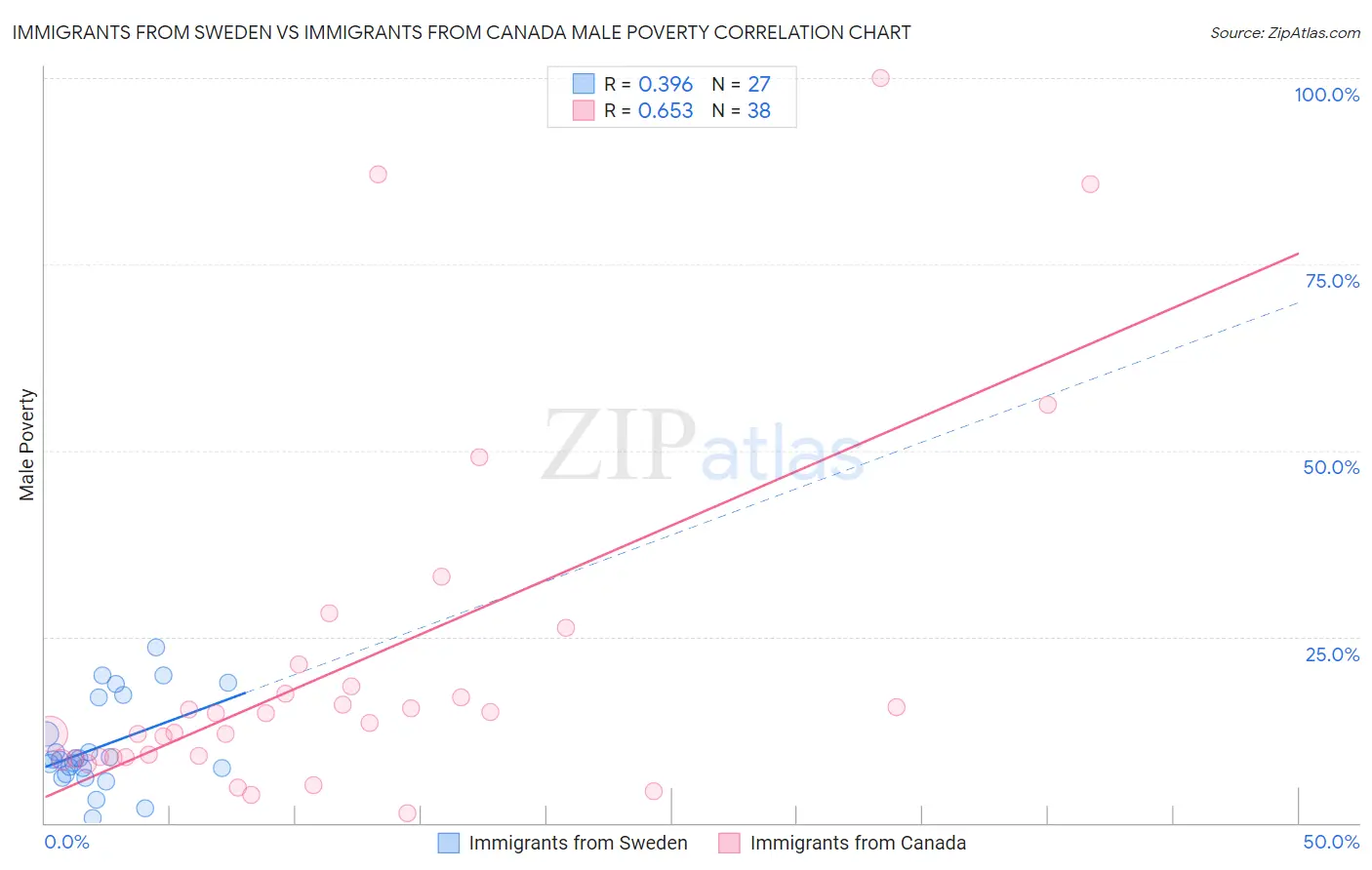Immigrants from Sweden vs Immigrants from Canada Male Poverty
COMPARE
Immigrants from Sweden
Immigrants from Canada
Male Poverty
Male Poverty Comparison
Immigrants from Sweden
Immigrants from Canada
10.3%
MALE POVERTY
95.7/ 100
METRIC RATING
83rd/ 347
METRIC RANK
10.2%
MALE POVERTY
97.1/ 100
METRIC RATING
72nd/ 347
METRIC RANK
Immigrants from Sweden vs Immigrants from Canada Male Poverty Correlation Chart
The statistical analysis conducted on geographies consisting of 164,680,167 people shows a mild positive correlation between the proportion of Immigrants from Sweden and poverty level among males in the United States with a correlation coefficient (R) of 0.396 and weighted average of 10.3%. Similarly, the statistical analysis conducted on geographies consisting of 458,819,233 people shows a significant positive correlation between the proportion of Immigrants from Canada and poverty level among males in the United States with a correlation coefficient (R) of 0.653 and weighted average of 10.2%, a difference of 1.1%.

Male Poverty Correlation Summary
| Measurement | Immigrants from Sweden | Immigrants from Canada |
| Minimum | 0.65% | 1.3% |
| Maximum | 23.6% | 100.0% |
| Range | 23.0% | 98.8% |
| Mean | 10.2% | 21.2% |
| Median | 8.6% | 14.1% |
| Interquartile 25% (IQ1) | 6.6% | 8.8% |
| Interquartile 75% (IQ3) | 16.8% | 18.3% |
| Interquartile Range (IQR) | 10.2% | 9.5% |
| Standard Deviation (Sample) | 6.0% | 23.5% |
| Standard Deviation (Population) | 5.9% | 23.2% |
Demographics Similar to Immigrants from Sweden and Immigrants from Canada by Male Poverty
In terms of male poverty, the demographic groups most similar to Immigrants from Sweden are Czechoslovakian (10.3%, a difference of 0.060%), Immigrants from England (10.4%, a difference of 0.11%), Egyptian (10.3%, a difference of 0.12%), Belgian (10.3%, a difference of 0.13%), and Immigrants from Eastern Asia (10.4%, a difference of 0.25%). Similarly, the demographic groups most similar to Immigrants from Canada are European (10.2%, a difference of 0.010%), Paraguayan (10.2%, a difference of 0.030%), Immigrants from Australia (10.2%, a difference of 0.050%), Immigrants from Asia (10.2%, a difference of 0.080%), and Immigrants from Eastern Europe (10.2%, a difference of 0.16%).
| Demographics | Rating | Rank | Male Poverty |
| Immigrants | Netherlands | 97.3 /100 | #67 | Exceptional 10.2% |
| Immigrants | Sri Lanka | 97.2 /100 | #68 | Exceptional 10.2% |
| Immigrants | Australia | 97.1 /100 | #69 | Exceptional 10.2% |
| Paraguayans | 97.1 /100 | #70 | Exceptional 10.2% |
| Europeans | 97.1 /100 | #71 | Exceptional 10.2% |
| Immigrants | Canada | 97.1 /100 | #72 | Exceptional 10.2% |
| Immigrants | Asia | 97.0 /100 | #73 | Exceptional 10.2% |
| Immigrants | Eastern Europe | 96.9 /100 | #74 | Exceptional 10.2% |
| Carpatho Rusyns | 96.9 /100 | #75 | Exceptional 10.2% |
| Dutch | 96.9 /100 | #76 | Exceptional 10.2% |
| Immigrants | Belgium | 96.8 /100 | #77 | Exceptional 10.3% |
| Irish | 96.8 /100 | #78 | Exceptional 10.3% |
| Immigrants | North America | 96.5 /100 | #79 | Exceptional 10.3% |
| English | 96.4 /100 | #80 | Exceptional 10.3% |
| Belgians | 95.9 /100 | #81 | Exceptional 10.3% |
| Egyptians | 95.9 /100 | #82 | Exceptional 10.3% |
| Immigrants | Sweden | 95.7 /100 | #83 | Exceptional 10.3% |
| Czechoslovakians | 95.6 /100 | #84 | Exceptional 10.3% |
| Immigrants | England | 95.5 /100 | #85 | Exceptional 10.4% |
| Immigrants | Eastern Asia | 95.3 /100 | #86 | Exceptional 10.4% |
| Northern Europeans | 95.2 /100 | #87 | Exceptional 10.4% |